What to do with abrasions or blisters
 Whether playing soccer, running or fitness training. Skin injuries such as Scrapes or blisters are among the most common injuries in sports. Since you don't have to go to a doctor for minor injuries, it is good to know which points to consider. Here are a few tips on what you should have in your medicine cabinet.
Whether playing soccer, running or fitness training. Skin injuries such as Scrapes or blisters are among the most common injuries in sports. Since you don't have to go to a doctor for minor injuries, it is good to know which points to consider. Here are a few tips on what you should have in your medicine cabinet.
What to do with abrasions
Abrasions are generally superficial injuries to the skin. They should be rinsed thoroughly with clean water and gentle soap. The abraded area can then be disinfected. This prevents the wound from getting worse due to residual bacteria. It is best to let the abrasion dry in the air, which prevents bandages etc. from sticking to the wound and tearing it open again when removed. It also speeds up healing.
In the case of somewhat larger abrasions, it is advisable to cover them with a special wound pad, as extensive skin abrasions do not dry off. This keeps the wound clean and moist and without sticking. If the abrasion is deeper, a doctor should be consulted, as such larger injuries can put a strain on the immune system. This can also be used to check whether the vaccination against tetanus still exists.
What to do about blisters
Blisters are caused by prolonged irritation of the skin, e.g. too tight shoes when running. The blister skin should not be peeled off unless there is dirt underneath it. The bladder is covered with a sturdy plaster that sticks on all four sides. You can also use special blister plasters here, which are also waterproof and water-repellent. Ideally, you can now just continue training.
If there is dirt in the bladder because it is open, it must also be cleaned here. The skin of the bladder should be completely removed for this purpose and then carefully clean and disinfect the underlying skin area. Now, if possible, the wound should be able to dry in the air. Otherwise, use the plaster or blister plaster from the medicine cabinet again. In a few days, new skin should form again and the symptoms disappear.
Conclusion: Regardless of whether it is a scratch or a blister, the following applies to both: cleanliness and air are among the most important components for a good recovery.
In addition to things like disinfectants, plasters, wound dressings, etc., you should also have other helpers in your hand just in case Medicine cabinet have ready. You can find one here interesting guidewhat belongs in the optimally equipped medicine cabinet.
Prevention tip: The best tip for avoiding painful blisters on your feet is of course to use suitable running or competition shoes that have already been worn in for the competition. To prevent the formation of blisters on new shoes, it is advantageous e.g. Tape the toes or heels off before the competition.





Thanks for the tips, I currently have blisters on my feet after running ...
I think the good old sports shoes have had their day - it's time for real running shoes!